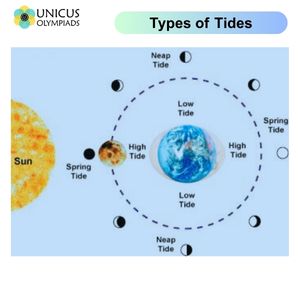

Tides are the regular rise and fall of sea levels caused by the gravitational forces exerted by the Moon and the Sun, along with the Earth’s rotation. While tides are most noticeable in coastal areas, they are an important natural phenomenon that impacts marine life, navigation, and coastal ecosystems. In this article, we will explore the causes of tides, how the Moon and Sun affect them, and the various types of tides that occur around the world.
Tides refer to the periodic movement of water levels in the Earth’s oceans and seas. These movements occur in a regular cycle, typically every 12 hours, and consist of two phases: a rise in water level (high tide) and a fall in water level (low tide).

The primary cause of tides on Earth is the gravitational pull of the Moon. The Moon’s gravity pulls on the Earth’s oceans, creating a bulge of water on the side of the Earth facing the Moon. This bulge causes the water level to rise, creating a high tide. At the same time, on the opposite side of the Earth, another bulge forms due to the centrifugal force created by the Earth-Moon system’s rotation. This also results in a high tide on the opposite side of the planet.
The Sun also exerts a gravitational pull on the Earth, but its effect is weaker than that of the Moon because the Sun is much farther away. However, when the Sun, Earth, and Moon align, the Sun’s gravitational pull combines with the Moon’s pull, resulting in higher high tides and lower low tides, known as spring tides. This occurs during the full moon and new moon phases when the Earth, Moon, and Sun are in a straight line.
As the Earth rotates on its axis, different parts of the planet move in and out of the areas of the tidal bulge. This rotation causes the regular cycle of high and low tides. Because it takes the Earth approximately 24 hours to complete one full rotation, there are typically two high tides and two low tides each day, spaced about 12 hours apart.
The Moon has the greatest effect on Earth’s tides because it is much closer to the Earth than the Sun. Its gravitational pull creates two tidal bulges on Earth: one facing the Moon and one on the opposite side. These bulges result in the two high tides each day, while the areas between the bulges experience low tide.
Although the Sun is much farther from Earth than the Moon, it still plays a significant role in the tides. The Sun’s gravitational pull on the Earth’s oceans is about 46% of the Moon’s pull, so it does not create tides as strong as the Moon does. However, when the Sun and the Moon are aligned (during full moons and new moons), their gravitational forces combine to create higher high tides and lower low tides, known as spring tides.
The timing of tides varies depending on the location. Most coastal areas experience two high tides and two low tides every 24 hours and 50 minutes (a lunar day). This cycle is influenced by the positions of the Moon and the Sun relative to the Earth, with high tides typically occurring approximately 12 hours apart.
Tides also have a significant impact on navigation, particularly in shallow waters. Ships and boats must account for tidal fluctuations to avoid running aground or to access ports and harbors that may only be accessible at certain times of the day. In many places, tidal information is critical for safe maritime travel.
Climate change is contributing to rising sea levels due to the melting of polar ice caps and the thermal expansion of seawater. As sea levels rise, the effects of tides on coastal regions may become more pronounced, leading to increased coastal erosion, flooding, and damage to infrastructure.
Some studies suggest that climate change could alter tidal patterns by affecting the Moon’s orbit and the Earth’s rotation. These changes, along with rising sea levels, may increase the frequency and severity of tidal flooding in vulnerable coastal areas.